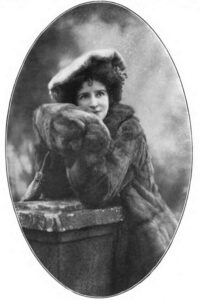
Secret History, Revealed by Lady Peggy O’Malley
One month before I met the white dress, Diana and Father and I had come from home—that’s Ballyconal—to see what good we could do with a season in London; good for Diana, I mean, and I put her before Father because he does so himself. He puts everyone else far behind, like the beasts following Noah into the Ark. It’s not that I’m sure, without looking them up, that they did follow Noah. But if it had been Father, he would have arranged it that way to escape seeing their ugly faces or smelling those who were not friendly to smell.
I suppose I should have been left at Ballyconal with nothing to do but study my beloved French and Spanish, my sole accomplishments; only Father had contrived to let the place, through the New York Herald, to an American family who, poor dears, snapped it up by cable from the description in the advertisement of “a wonderful XII Century Castle.” Besides, Diana couldn’t afford a maid. And that’s why I was taken to America afterwards. I can do hair beautifully. So, when one thinks back, Fate had begun to weave a web long before making that white dress. None of those tremendous things would have happened to change heaven knows how many lives if I hadn’t been born with the knack of a hairdresser, inherited perhaps from some bourgeoise ancestress of mine on Mother’s side.
When the American family found out what Ballyconal was like, the twelfth-century rats had crept out from the hinterland of the old wainscoting (“rich in ancient oak,” the advertisement stated) to scamper over its faces by night. Door knobs had come off in its hands by day, or torn carpets had tripped it up and sprained its ankles, it said bad words about deceitful, stoney-broke Irish earls, and fled at the end of a fortnight, having paid for two months in advance at the rate of thirty-five guineas a week. Father had been sadly sure that the Americans would do that very thing, so he had counted on getting only the advance money and no more. This meant cheap lodgings for us, which spoiled Diana’s chances from the start, as she told Father the minute she saw the house. It was in a pretty good neighbourhood, and the address looked fashionable on paper. Still, men, especially girls, may not live alone in the neighbourhood and on paper, even if the latter can be peppered with coronets.
Read or download Book
A. M. Williamson
Alice Muriel Williamson (8 October 1858 – 24 September 1933), who published chiefly under names the “C. N. and A. M. Williamson” and “Mrs. C. N. Williamson,” was an American-English author.
Biography
She was born on 8 October 1858 to parents Marcus and Jane (Thomas) King in Cleveland, Ohio, where her father was co-founder of the Ohio State and Union Law College. In 1890 she adopted the surname “Livingston” from her maternal great-grandfather following her separation from her first husband, Lieutenant William Reeve Hamilton, who disapproved of her budding career as an actress. In 1892 she expatriated herself to England (and from her first husband) as a foreign correspondent for the Boston Evening Transcript, supplying that paper with approximately 120 “letters” between 1892 and 1897 before devoting herself full-time to fiction, although she remained a occasional freelance journalist for the rest of her life. Two years after arriving in England she married magazine editor Charles Norris Williamson (1857–1920) whom she persuaded to appear as co-author for many of her books, later acknowledging her sole authorship.
Her success as an author, in its early stages, was owing to Alfred Harmsworth who, recognizing her talent, promoted her stories – especially sensational serials – in the Daily Mail and his many other publications. Her first serial, “Confessions of a Stage-Struck Girl,” appeared in Forget-Me-Not (August 11-November 17, 1894), partly inspired by her earlier career as an actress in America, as was her first novel, The Barnstormers (1897), written at the suggestion of S. R. Crockett upon hearing her describe some of her theatrical experiences at a dinner party. Her second novel, A Woman in Grey (1898), established her reputation as a worthy successor to Wilkie Collins. A third, The Newspaper Girl (1899), exploited Elizabeth Banks’s “stunt” journalism, turning some of the same stratagems to humorous effect. Humor would become one of her most striking characteristics as an author, beginning with The Lightning Conductor (1902), the novel that catapulted her overnight to international fame, selling more than a million copies in America. James Milne, in Memoirs of a Bookman (1934), speaks of a “tradition” that she was “the wittiest girl who ever invaded Fleet Street.”
Although best known for her series of motor travel romances, she was a literary polymath adept at a wide variety of genres (detective, mystery, Gothic, spy, adventure, war, ghost, fairy, satire, fictional memoir, muckraking, etc.), often published anonymously or pseudonymously, such as Champion: The Story of a Motor Car (1907) as by John Colin Dane (memoirs narrated by the car itself), and her sensational exposé of German war plans on the eve of World War I, What I Found Out in the House of a German Prince (1915), purporting to be “by an American-English Governess,” the latter so realistic that it was accepted as a true account and published serially in the Fortnightly Review.
She died on 24 September 1933 under strange circumstances at Bath, where her remains are interred next to those of her husband in the graveyard behind Bath Abbey.






